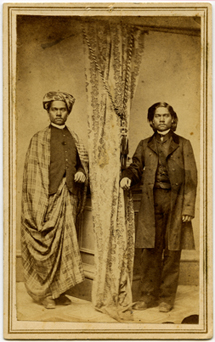
|
We do not know if it was the photographer’s or Moung Kyau’s idea to produce this unusual double-exposure portrait. What was its intended meaning? Did he seek to show his double identity both as a Burmese man and as a Christian who had understood the ways of the Europeans well enough to dress like a gentleman and earn an education as a missionary? Are we meant to read this image as a progression, from left to right, from “heathen” to Christian? Is this then an example of European colonialism and triumphalism, working through the respectable front of Christian evangelism? Is Kyau a victim of cultural imperialism? But if Kyau had completely rejected his origins, why would he keep his traditional clothes? Did he understand himself as having a double or multiple identity, rather than a divided one?
Kyau studied in the eastern United States, after what must have been a very long voyage from Burma, probably supported by the Baptist missionaries who converted him and saw his potential as a preacher to his own people. Asian visitors were not common in the eastern part of the United States at this time (the 1860s), and especially if they were involved in education and religious work, they might well gain some acceptance in white society. Isolated individuals such as Kyau were not perceived as a racial threat and might even gain respect as exotic curiosities or as signs of the global triumph of white Christian civilization.
In California, by contrast, where tens of thousands of Asians, mostly Chinese, immigrated for the Gold Rush, their sheer numbers and competition for jobs with whites exposed them to prejudice and abuse. |

